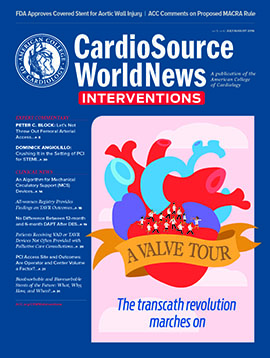ACCEL: Paradigms for the Ablation of Persistent Atrial Fibrillation | Atul Verma, MD
CardioSource WorldNews Interventions | It has been more than 8 years since the first patient was enrolled in the pivotal TTOP-AF (Tailored Treatment of Persistent Atrial Fibrillation) study,1 which initially evaluated the performance of a multipolar, phased radiofrequency (RF) system (Ablation Frontiers, Medtronic, Inc.). In brief, phase-shifted energy delivered between adjacent catheter electrodes (bipolar) and return electrodes (unipolar) allowed for creation of long contiguous lesions. The efficacy of the technology was quite promising showing that nearly 56% of patients experienced substantial improvement in AF burden at 6 months.
At least for now, it should be noted that ablation is for symptomatic improvement only; there is no evidence to date of a mortality benefit nor other beneficial clinical effect (such as any reduction in stroke risk). But for symptomatic improvement and QOL, ablation can be beneficial.
In smaller studies, the technology also achieved outcomes comparable with traditional, single-point RF technology while significantly reducing procedural time. Consequently, discussion during the U.S. Food and Drug Administration (FDA) panel hearing in 2011 showed unanimity that the technology was effective in the treatment of persistent AF. However, due to safety concerns, the technology was not approved; highly concerning in particular: the peri-procedural stroke rate in TTOP-AF was 2.9%. There were also studies showing that the incidence of asymptomatic cerebral emboli post-ablation was significantly higher with phase-shifted RF technology compared with open-irrigated, single-point RF and cryoablation.
Face it: persistent AF is a challenge. Percutaneous catheter ablation remains an effective treatment for paroxysmal AF, particularly in patients refractory to antiarrhythmic medications. As Atul Verma, MD, Southlake Regional Health Centre, Newmarket, Ontario, noted,2 most triggers for paroxysmal AF come from the pulmonary veins, so ablation involves creating circumferential lesions around the veins to electrically isolate them from the rest of the left atrium. Catheter ablation for persistent AF is more difficult and is associated with less favorable outcomes.
To improve outcomes, ablation targeting the substrate that maintains fibrillation (i.e., substrate modification) is often added (per the guidelines) to pulmonary vein isolation (PVI). Recently Dr. Verma and colleagues published the results of STAR AF II (the Substrate and Trigger Ablation for Reduction of Atrial Fibrillation Trial Part II).2 This randomized trial compared three strategies of ablation for persistent AF:
- ablation with pulmonary-vein isolation (PVI) alone (n = 67);
- PVI plus ablation of electrograms showing complex fractionated activity (n = 263); and
- PVI plus additional linear ablation across the left atrial roof and mitral valve isthmus (n = 259).
As you can imagine, procedure time was significantly shorter for PVI alone compared to the other two procedures (p < 0.001). What did you get for the extra procedural time? After 18 months, 59% of patients assigned to PVI alone were free from recurrent AF versus 49% of patients assigned to PVI plus complex electrogram ablation, and 46% of patients assigned to PVI plus linear ablation (p = 0.15). So, not much. There were also no significant differences among the three groups for secondary endpoints, including freedom from AF after two ablation procedures and freedom from any atrial arrhythmia.
Serious adverse events included three instances of cardiac tamponade and three instances of stroke or transient ischemic attack. In one patient assigned to isolation plus electrograms, a procedure-related atrioesophageal fistula developed that was complicated by stroke; this was successfully treated by esophageal stenting, but the patient died 3 months later of aspiration pneumonia.
The only complications seen with PVI alone: two patients had an access site hematoma; one patient experienced a skin burn; and one patient suffered one of the three tamponades. The other 30 adverse events were spread across the other two groups.
Guidelines Not Supported
Verma and colleagues noted that their findings are not in accordance with current guideline recommendation that patients with persistent AF who undergo PVI should have additional substrate ablation to improve outcome. The good news: PVI alone can achieve a successful outcome in about half of patients with persistent AF.
Why the guidelines-endorsed approach did not add benefit in STAR AF II is unclear. Verma et al. hypothesize that more extensive ablation may cause new, iatrogenic areas of arrhythmogenesis where tissue is incompletely ablated or linear block is not achieved. Perhaps neither complex electrograms nor lines are the correct supplemental targets for ablation. More selective targets may be needed to better characterize an individual patient’s specific arrhythmic substrate.
Perhaps the lack of benefit seen with performing additional, and possibly unnecessary, ablation increases risk. After all, procedure time in STAR AF II was longer by almost an hour in the additional-ablation groups and was associated with increased exposure to fluoroscopy for the patient and the operator.
As Dr. Verma put it in a recent editorial comment: While data offer good news for patients and operators, the existing data are still derived largely from non-randomized, retrospective, or limited studies of few patients.3 As to how newer technologies will fit into our armamentarium of catheters for AF ablation, Dr. Verma wrote, “We need proper prospective, comparative, randomized trials.” Anything less than that, he added, will only keep us moving in circles.
References
- Hummel J, Michaud G, Hoyt R, et al; TTOP-AF Investigators. Heart Rhythm. 2014;11:202-9.
- Verma A, Jiang CY, Betts TR, et al. N Engl J Med. 2015;372:1812-22.
- Verma A. Europace. 2016 Mar 21. pii:euw004 [Epub ahead of print].
- De Greef Y, Dekker L, Boersma L, et al. Europace. 2016 Jan 29. pii:euv385 [Epub ahead of print].

|
Read the full July/August issue of CardioSource WorldNews Interventions at ACC.org/CSWNI |
Keywords: Atrial Fibrillation, Bipolar Disorder, Catheters, Cryosurgery, Electrodes, Hearing Tests, Incidence, Intracranial Embolism, Stroke, United States Food and Drug Administration, CardioSource WorldNews Interventions
< Back to Listings
